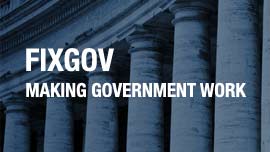From New York City’s historic mayoral contest to decisive Democratic wins in Virginia and New Jersey, the 2025 off-year elections provide early indicators of voter sentiment and party dynamics as we head toward the 2026 midterms and beyond. In this analysis, Brookings scholars E.J. Dionne Jr., Elaine Kamarck, Darrell West, and William Galston explore what the results may signal for upcoming state and national contests.
Can Mamdani govern like La Guardia?
Many noticed New York City Mayor-elect Zohran Mamdani’s reference to Eugene Debs, the famous American Socialist leader, right at the top of his election night victory speech. After a post-primary campaign that spent a lot of time reassuring voters that his goal was to lead a responsive and effective government, Mamdani wanted to remind everyone that, yes, he really is a democratic socialist.
But the more telling reference came later in the speech, to one of the city’s most storied mayors, Fiorello La Guardia. Like Mamdani, La Guardia was seen by his critics as a radical. A left-wing Republican when such a breed still existed, La Guardia was elected to one of his terms in Congress on the socialist ticket when his own party temporarily dumped him. But La Guardia’s progressivism was transformative for the city with his emphasis on infrastructure, transit, parks, slum clearance, public housing, assistance to the poor and the working class, and much more. In the end, Mamdani knows, as he put it before the election, that “the most important thing is delivering.”
One big difference: La Guardia had the advantage of cooperating with a like-minded presidential administration led by Franklin D. Roosevelt. As Mamdani made clear, he knows he will be doing battle with President Trump, who has many ways of exerting influence on the city. Their confrontation could be epic.
When Mamdani defeated former Governor Andrew Cuomo in the Democratic primary in June with just over 573,000 votes in the final round of counting under the city’s ranked-choice voting system, his critics diminished the significance of his victory by arguing that the Democratic primary electorate in the city was inevitably skewed to the left.
This is what made his mobilization of an extraordinary turnout in his general election with Cuomo so remarkable. He was the first mayoral candidate to crack 1 million votes since John V. Lindsay’s re-election in 1969, and, with some ballots still to be counted, Mamdani’s vote total was the largest since Lindsay’s first election four years earlier.
He did it by putting together a new coalition that the New York Times’s David Wallace-Wells aptly called an “emergent coalition of the precariat.” That’s different from the proletariat, since many in the group Wallace-Wells describes have decent-enough incomes, but are pressed by the unaffordability of life in New York City.
Mamdani’s constituency certainly tilts toward the highly educated. The SSRS exit poll for a media consortium found that he defeated Cuomo among college graduates, 57% to 38%, but lost voters without college degrees, with 40% to Cuomo’s 48%.
The income split in voting was more telling. Cuomo narrowly won the very lowest income voters (those with annual incomes under $30,000), 48% to 42%, and swamped Mamdani among the city’s richest voters (those earning $300,000 or more), 62% to 33%.
Mamdani won every other income group in between, with his strongest showing coming among voters in the $50,000 to $200,000 range.
He also led an electoral revolution of the young, beating Cuomo by 44 points among voters under 45 years of age, but losing older voters by 11 points. The younger the voter, the better Mamdani did: he secured 78% among voters under 30.
After a very bad election night for their party, Republicans focused on highlighting Mamdani’s socialism and claiming (despite the sweeping gubernatorial victories of moderate Democrats Mikie Sherrill in New Jersey and Abigail Spanberger in Virginia) that he, not they, reflects the Democratic party’s true colors.
It’s unlikely to work, partly because most Americans are not obsessed with who is running New York City. But Mamdani’s performance in office will help determine whether this line of attack gains traction. If “what would Fiorello do?” becomes his lodestar, he could live up to his hope that what some see as radicalism can turn into what many might call visionary. Of course, La Guardia did not have to deal with President Trump.
Moderate women governors could become the new face of the Democratic Party
Election night 2025 was a big one for beleaguered Democrats. There were important margins in several states and improved party fortunes nearly across the board. But no one should jump to premature conclusions about what this means for the upcoming midterm elections. In fact, as my colleague E.J. Dionne has written in a comprehensive study of off-year elections, “Occasionally, they are prophetic; often, not so much.”
Nonetheless, there are telling hints to be found in the two big governors’ races—New Jersey and Virginia. In both races, affordability ranked high on voters’ minds, approval of President Trump among the electorate was low, and Democrats performed better than their party’s presidential candidate had done in 2024. In New Jersey, Representative Mikie Sherrill won a solid 13-point victory over her opponent, Jack Ciattarelli. The margin of victory matters because New Jersey, though reliably blue, showed signs of weakness for Democrats when presidential candidate Kamala Harris won by only six points in 2024. For instance, in northern New Jersey, nearly 20% of the towns that backed Biden in 2020 flipped to Trump in 2024.
Among the areas that Trump won was Passaic County, where 42.7% of residents identify as Hispanic or Latino. Passaic County thus became the poster child for a trend, present in 2024, of Hispanic voters moving away from Democrats. Passaic cast 95,155 votes for Harris in 2024 compared to 100,955 for Trump. But in the governor’s race, the numbers flipped, and Sherrill received 82,152 votes while Ciatterelli won 60,649. This suggests that the recent drift of Hispanic voters away from Democrats might be temporary. Hispanic voters appear driven by both affordability concerns as well as opposition to Trump’s deportation policies. In the most densely Hispanic area of Virginia, Manassas Park City, the Spanberger vote in 2025 was 12 points higher than the Harris vote in 2024 (70.8% to 58.5%).
In Virginia, Democrat Abigail Spanberger beat her Republican opponent, Winsome Earle-Sears, by 14.6%—another very solid victory. This margin was more than double Harris’ six-point win over Trump in 2024. Spanberger was aided by the fact that Virginia is home to 320,000 federal government workers who have directly experienced the effects of the Trump administration’s cuts to the federal government. Opposition to these Trump policies is being felt across the country, but in Virginia, the issue is a personal matter for many families.
Another gauge of this is that in the race for attorney general, Democrat Jay Jones won even though screenshots of messages surfaced in which he said that he wished his opponent’s children would die in their mother’s arms. His margin of victory was almost half of Spanberger’s, but substantial nonetheless at 6.6%. Democrats swept every other statewide race and added to their numbers in the House of Delegates, meaning that it will be easier for them to pursue mid-decade redistricting.
The two winning gubernatorial candidates were centrist women with strong national security credentials. Some analysts suggest that if leaders like them become the new face of the Democratic Party, Democrats could regain the ground lost to Trump in 2024. At the same time, the picture is muddied by the election of Democratic socialist Zohran Mamdani as mayor of New York City, who some people view as too far left for the rest of the country. Nonetheless, victories in important contests in California, Pennsylvania, and Maine may point to a comeback for Democrats heading into 2026 and 2028. Sometimes, off-year elections do hint at broader national trends.
Maine rejects restrictions to voting access
President Donald Trump has proposed changes to election rules he thinks will help Republicans in the coming years. In a March 2025 executive order, he mandated that states require mail ballots to be received by election day and proof of citizenship to be shown at registration time. These complaints harken back to the 2020 presidential election, when Trump said that new laws designed to facilitate voting during the COVID pandemic were helping Democrats cheat. Since then, he has argued that mail ballot restrictions and voter ID requirements benefit Republicans.
The country got its first voter reaction to some of these proposed changes from the Maine elections this week. On the ballot were several far-reaching reforms designed to restrict access to the vote: requiring voter identification, shortening the period for absentee balloting, eliminating absentee options for senior citizens and the disabled, and limiting the number of ballot drop boxes. Proponents argued these alterations would reduce election fraud, while opponents tagged them as voter suppression that would make it more difficult for Democratic-leaning groups to cast ballots.
The results are instructive for how people in the New England state feel about these efforts. Mainers rejected the proposed Question 1 changes by 64% to 36%. Along with the 63% victory of a proposition allowing temporary restrictions on dangerous weapons if the individual poses a risk to themselves or others, this election measure was a decisive win for voting access and a striking rebuke of President Trump’s policy on the matter. The strong showing demonstrates that the president’s ideas lack support from the general public and that the electorate wants to maintain the voting status quo.
The result is noteworthy because of the involvement of conservative groups tied to the Republican State Leadership Committee, which raised over $500,000 in support of voting restriction measures. The group Save Maine Absentee Voting opposed the proposition and worked with the National Education Association to raise $1.6 million against it.
This outcome may make it easier for Democrats to contest the upcoming Maine Senate election. The Pine Tree State will hold one of the most pivotal 2026 races, involving the seat currently held by Republican Susan Collins. Many are paying attention to it because of its importance for party control of the U.S. Senate. The GOP currently has a three-seat advantage, and there is virtually no way Democrats can make inroads without winning in Maine. If enacted, the Maine ballot restrictions likely would have made it more difficult for some people to vote, especially for Democratic-leaning constituencies.
Along with decisive Democratic wins for Virginia and New Jersey governorships, the New York City mayor’s race, and the California redistricting votes, the Maine tallies demonstrate that a possible political backlash is building against Trump’s policy agenda. People are worried about affordability, access to quality healthcare, and the future of democracy. Taken together, these victories may foretell broader voter opposition in 2026 and 2028 to President Trump and the Republican Party.
Why the California Prop 50 results are so important in advance of the 2026 midterms
Among the many important electoral outcomes this week are the results of the vote on California’s Prop 50. This ballot initiative represents the opening salvo in the fight for control of the House of Representatives in 2026.
The story begins in August 2025 in Texas, when the state legislature passed a law creating new lines for congressional districts in the middle of the decade instead of after the decennial census, as it had normally been done. The new maps would create five potentially Republican districts. The act, while unprecedented in its partisan scope and unusual in its timing, was completely legal.
Immediately, California’s Democratic Governor Gavin Newsom pushed for a response in his state. For years, a non-partisan commission has drawn California’s congressional districts. The proposition spearheaded by the governor and on the ballot this week allows temporary redistricting in response to the actions taken in Texas. California’s newly-drawn districts would create five new Democrat-leaning congressional districts, lasting for 3 election cycles. The measure passed overwhelmingly, with 63.9% voting in favor and 36.1% against. Exit polls showed that the victory was broad and reflected significant opposition to Trump in the state. Newsom was successful at altering the frame of this ballot measure from a gerrymandering battle to the larger fight over fair elections and the future of democracy. Had voters seen this as just one more partisan redistricting effort, it likely would not have received nearly two-thirds of support.
To fully understand the importance of the California vote, it’s important to note that over time, the number of competitive congressional seats has shrunk. Looking towards the 2026 midterms, a study from The Brennan Center finds that there will be fewer competitive districts in those elections than at any time in the last 52 years. These midterms will take place as the second Trump administration attempts, often successfully, to expand executive power—and make Congress obsolete in the process. For Democrats, taking control of the House of Representatives will be a crucial step to stop, or at least slow down, President Trump’s efforts.
As the Texas–California redistricting contests played out, many more states, prodded on by their leaders in Washington, got in on the act. In Ohio, the Republican commission passed a compromise map that added two Republican seats. In Missouri, Republicans hope to pick up one seat, and Democrats are attempting to force a statewide vote before this takes effect. In North Carolina, a new map targets Democratic Representative Don Davis. In Utah, a court order could give the Democrats one seat.
In other states, discussions are ongoing. Virginia could add 3 Democratic seats, which makes the party’s legislative gains on Tuesday all the more influential. In Maryland, Governor Wes Moore seeks to pick up one Democratic seat by targeting the lone Republican in the delegation. In Florida, Nebraska, and Indiana, talks are underway.
In a country as divided as the United States today, the unthinkable can actually happen. States succeeded in redrawing their district lines mid-decade, contrary to the usual end-of-decade timeline. A proposition on the obscure business of drawing district maps turns into a state referendum on a sitting president and wins. The outcome of the 2026 midterms and control of the House may hinge on how many states pursue their redistricting efforts to the end.
Pennsylvania and beyond: Why state judicial races matter more than ever
By the end of October, more than $9 million had poured into Pennsylvania’s normally obscure judicial elections. Here’s why.
In 1968, Pennsylvania adopted an unusual system for selecting Supreme Court justices. Candidates first run with partisan labels for 10-year terms. If they want to remain on the Court after their terms expire, they do not face opponents. Instead, they are subject to a non-partisan “retention” election. If the majority votes to keep them, they get another term. If not, an election is needed to replace them, unless the governor appoints interim replacements, a process that requires approval from two-thirds of the state senate.
Since the adoption of this system more than half a century ago, only one justice has lost their race for retention. It seemed that this year might be different, and both major political parties turned these usually sleepy races into ones deserving of national attention.
The Pennsylvania Supreme Court’s 7 justices are now divided 5-2 in favor of Democrats. But this year, 3 Democratic justices were up for retention. If they had not been renewed, the Court would have been deadlocked 2-2, probably for an extended period. The Republican-controlled Senate would have been in no hurry to ratify Democratic governor Josh Shapiro’s interim nominees, and Pennsylvania law does not provide for special judicial elections ahead of the regular elections scheduled for 2027.
This outcome would have had a significant impact on many controversial issues, especially the conduct of state elections, in which the Pennsylvania Supreme Court has played an active role. Jack Keith of Court Report summarizes the recent record. In 2018, the three Democratic justices up for retention this year provided key votes for a ruling declaring that partisan gerrymandering violated the state’s constitution, a decision that led Republican legislators to file articles of impeachment against them. In the 2020, 2022, and 2024 elections, these justices supported measures that made it “easier for eligible voters to vote and to have their ballots counted.” If the voters opted not to retain them, the state’s voting procedures would have been up for grabs during the crucial 2026 midterm elections.
The Pennsylvania Supreme Court has also played a key role in the abortion issue. While the Court has not yet decided whether the state’s constitution guarantees access to abortion, everyone knows that cases squarely raising this issue will reach the court before long. Without the three justices who faced the voters this week, their replacements could have moved this contested question in a different direction.
Against this backdrop, it was no accident that outside groups spent so much money for and against the justices’ retention. Nor was it surprising that Eugene Pasquale, the new chair of the Pennsylvania Democratic party, was expressing deep anxiety about these races in the days before the election. Winning a majority for their retention “is going to be hard,” he said. These elections are usually sleepy, low-turnout affairs, but with the new national attention, it was impossible to gauge which parts of the electorate would be motivated enough to vote.
In the end, Pasquale’s concerns turned out to be misplaced, as all three justices won overwhelming majorities for retention. But these races are part of a larger story. As the battleground for voting procedures and social issues shifts from a gridlocked Washington to the states, the outcome of state judicial elections will be increasingly important. In Illinois in 2020 and Oklahoma in 2024, conservatives won anti-retention campaigns. Last year, more than $100 million was spent on a hotly contested Wisconsin state Supreme Court race.
As the midterm elections loom, there is no reason to expect this spike of attention and money to subside. The country learned after the 2020 presidential election that state courts play a major role in resolving disputes about voting issues that can determine the course of national politics. Such disputes could recur in 2028—another reason why we should take state judicial elections seriously.
The Brookings Institution is committed to quality, independence, and impact.
We are supported by a diverse array of funders. In line with our values and policies, each Brookings publication represents the sole views of its author(s).








Commentary
2025 election wrap-up: Insights from Brookings
November 6, 2025